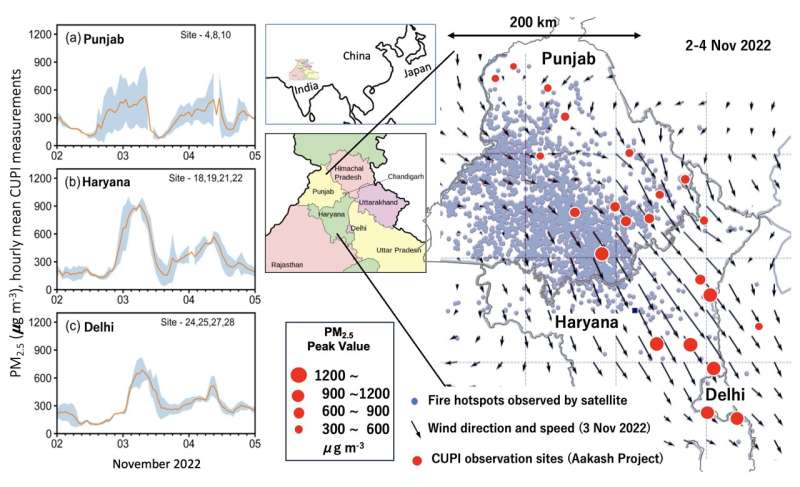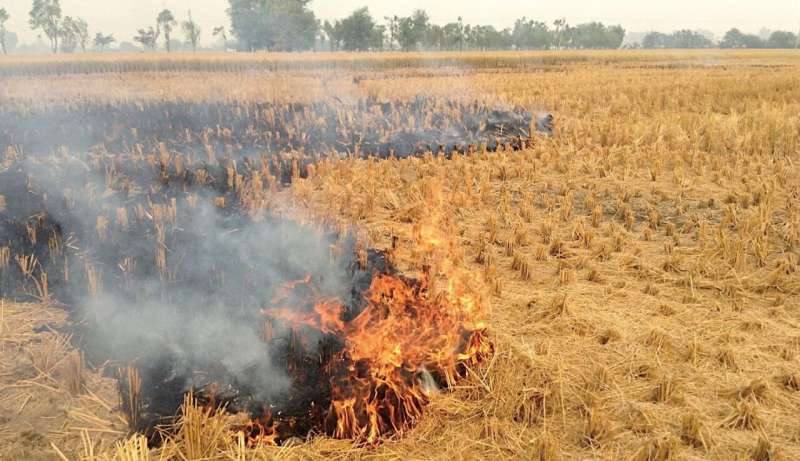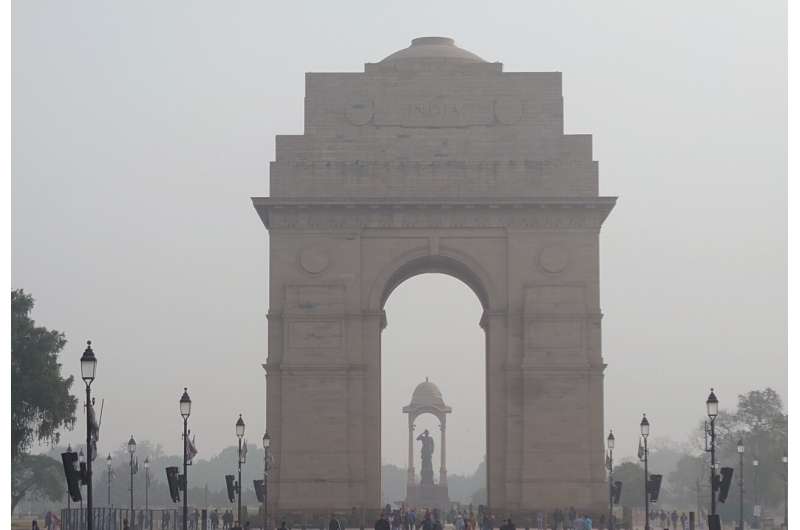This article has been reviewed according to Science X's editorial process and policies. Editors have highlighted the following attributes while ensuring the content's credibility:
fact-checked
peer-reviewed publication
proofread
Dense measurement network reveals high level of PM2.5 in Punjab due to crop residue burning

A group of international collaborators led by the Research Institute for Humanity and Nature (RIHN) team performed the first quantitative study of air pollution in the north-western India region using 29 low-cost and reliable instruments, demonstrating the advantages of source region observations to link crop residue burning (CRB) and air pollution at local to regional scales. The group published their findings in Scientific Reports.
Exposure to particulate matter less than 2.5 µm in diameter (popularly known as PM2.5) causes health hazards in cities and major emission regions of the world. Although the major sources of PM2.5 are industrial, agricultural practices contribute to the fine particle emission and formation in certain seasons.
The CRB, occurring immediately after the paddy harvest in the post-monsoon (September–November), is a common practice in Punjab, Haryana and part of Indo-Gangetic Plain (Photo 1). The CRB activities have increased in the past two decades, following the introduction of mechanized agriculture in the 1990s and delayed rice planting in Punjab and Haryana following the Preservation of Subsoil Water Act (2009).
Although the role of CRB in Punjab and Haryana on severe air pollution in the megacity Delhi national capital region (NCR) has been in the news since the mid-2010s, no measurements of PM2.5 in the source regions have been conducted. An intensive field campaign involving the states of Punjab, Haryana and Delhi NCR was conducted from September 1 to November 30 in 2022 using 29 Compact and Useful PM2.5 Instruments with Gas sensors (CUPI-Gs).
Continuous observations show that the PM2.5 in the region increased gradually from less than 60 µg m-3 from 6–10 October to up to 500 µg m-3 on 5–9 November, which subsequently decreased to about 100 µg m-3 from 20–30 November. The Indian national air quality standard for PM2.5 are 40 and 60 µg m-3 for annual and 24-hour exposure, respectively.
The measurements show PM2.5 values in the Punjab to Delhi NCR remained over 60 µg m-3 from mid-October to the end of November and crossed over 200 µg m-3 for the first two weeks of November at many sites. Two distinct CRB plumes of PM2.5 over 500 µg m-3 are tracked from Punjab to Delhi NCR via Haryana on 2–3 and 9–11 in November 2022 associated with the northwesterly monsoon.
Higher concentrations observed in the southeast downwind regions indicate the presence of secondary formation (gas to particle conversion in the atmosphere due to chemical reactions). The experimental campaign demonstrates the advantages of source region observations to link CRB and air pollution at local to regional scales.

"Reduction of air pollutants is possible with public awareness when implemented effectively. After all maximum sufferers reside where air pollutants are emitted (unlike the worldwide impacts of long-lived greenhouse gases)," says Prof. Prabir K. Patra, current leader of the Aakash Project at RIHN and principal scientist at Japan Agency for Marine-Earth Science and Technology (JAMSTEC).
"Within a limited budget, detailed behavior of air pollutants over a wide area from Punjab to Delhi NCR were obtained with the development of CUPI-G, and these are being used for measurement of air pollution in various other parts of Asia," says Professor Emeritus Yutaka Matsumi, of the Institute for Space-Earth Environmental Research at Nagoya University. The sensors are developed by Panasonic Corporation and members of Nagoya University.
"Let our efforts to build a greener and cleaner future be guided by the precision of low-cost PM2.5 monitoring, leading to cleaner air and a healthier livelihood for both rural and urban citizens," says Professor Manpreet Singh Bhatti at the Department of Botanical and Environmental Sciences, Guru Nanak Dev University.
There are many other environmental impacts of air pollution. Pollutants from CRB contain large amounts of light-absorbing aerosols, which can modify the thermodynamics of our atmosphere as well as cloud properties. "High-quality data obtained from a dense measurement network has a great potential to address these issues by combining multiple data streams and numerical models," says Dr. Pradeep Khatri, a researcher at Tohoku University.
Prof. Sachiko Hayashida (RIHN), the former project leader and who supervised the measurement campaign says, "We hope future Japan-India collaboration helps to reduce serious air pollution in this area. Aakash Project is also working with Indian researchers on the ways to improve straw management without burning."

The measurement data of PM2.5 are made available from the RIHN database with open data sharing policy (https://aakash-rihn.org/en/data-set/).
This research was conducted as part of the Aakash Project, which is exploring ways to shift people's behavior to sustainable agriculture in the Punjab region to reduce the health hazards caused by air pollution, by clarifying scientifically the relationship between straw burning and local air pollution; raising awareness of the importance of maintaining clean air among residents by holding health classes and conducting health checkups; and working to propose effective ways to use rice straw.
More information: Tanbir Singh et al, Very high particulate pollution over northwest India captured by a high-density in situ sensor network, Scientific Reports (2023). DOI: 10.1038/s41598-023-39471-1
Journal information: Scientific Reports
Provided by Research Institute for Humanity and Nature




















